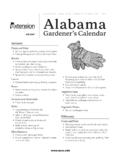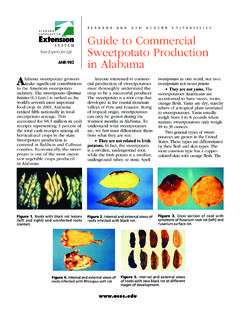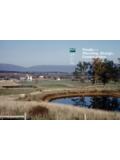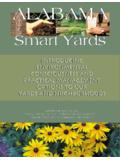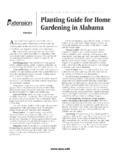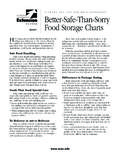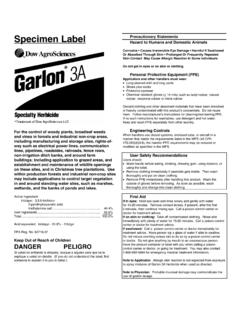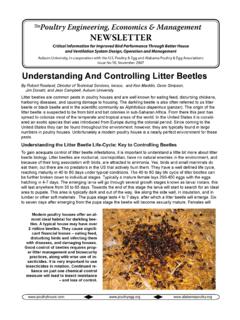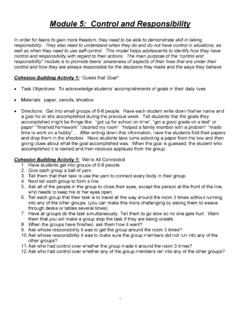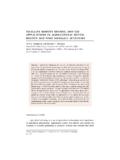Transcription of AlAbAmA A&m And Auburn universities Basal Area: A …
1 ANR-1371 AlAbAmA A&m And Auburn area : A measure made for managementAssume you have 40 acres of forestland that was recently assessed by a natural resource professional. the resulting timber appraisal states that there is an estimated 90 square feet of Basal area per acre and the trees have an average diameter of 10 inches. What does that really mean? From the description, can you picture what the forest looks like? Or more importantly, do you know how that number could be used to help you with future forest management options?From time to time, you might encounter unfamiliar forestry terms as you interact with land management professionals or read forestry- and wildlife-related publications.
2 Indeed, Basal area might be one of these unfamiliar terms. For foresters, Basal area is one of the most easily understood terms, but it may also be one of the most misused terms in forestry. this publication will help you better understand what Basal area is and why it is an important forest area is used to determine more than just forest stand density; it is also linked with timber stand volume and growth. therefore, it is often the basis for making important forest management decisions such as estimating forest regeneration needs and wildlife habitat requirements.
3 The manipulation of stand Basal area to achieve forest management goals can be as important as the use of prescribed fire or other vegetation treatments. What Is Basal area ?Part of the confusion about the term might have to do with the fact that Basal area can be thought of in two different ways:the Basal area of a tree is defined as the cross-sectional area (usually in square feet) of a single tree at breast height, or 4 feet above ground. the diameter of a tree at 4 feet above the ground is called diameter at breast height (dbH). the cross-sectional area of all stems of a species or all stems in a stand measured at breast height and expressed as per unit of land Not Trees Per Acre?
4 Trees per acre (tPA) is a common measure of the number of standing trees that are found on an acre of land. it is also relatively easy to understand as a way to calculate stand density, or how crowded trees are in a stand. trees per acre does not take into account the size of trees; instead it is based on the distance between or the spacing of trees on a site. in a plantation, the number of trees per acre can be estimated given the spacing within a row of trees and the distance between the rows. Trees per acre is an appropriate term to describe stand density in young stands, whether a plantation or naturally regenerated stand.
5 But as trees grow, this becomes less meaningful, especially when estimating timber volumes. For instance, a stand of 6-inch dbH trees averaging 100 trees per acre does not contain the same volume of wood as 100 trees per acre of 16-inch dbH trees. similarly, timber stands can have the same Basal area yet look very different on the ground. the diameter of trees at dbH determines how many trees per acre it takes to make a given Basal area . Figure 2 illustrates graphically how many 6-, 10-, 14-, and 18-inch trees you would have on a 1/5-acre circular plot to make 60 square feet of Basal area per acre:Figure 1.
6 This is a stand of longleaf pine (Pinus palustris Mill.) with an average Basal area of 95 square feet per acre. Basal area is often stated simply as 95 square feet of Basal area or 95 BA. 14in Trees10in Trees10-in trees10in Trees14-in trees14in Trees2 AlAbAmA Cooperative extension systemHow Is Basal area Calculated?Picture an acre of trees cut off at dbH (4 feet). the total surface area of the stumps in square feet would be the Basal area of that mathematical terms: Basal area (square feet) = (pi /(4 * 144))*dbH2 = *DBH2 Where pi = , dbH = diameter breast number is called the foresters constant, which converts the measured inches into square on the calculations above, table 1 illustrates the square feet of Basal area per tree for several dbH classes.
7 Table 2 can serve as a guide to assist landowners and natural resource professionals when estimating trees per acre from certain Basal area measurements. Table 1. Basal area Per Tree, in Square Feet, for Trees That Are 1 to 30 Inches DBH 18in Trees6in Trees6-in trees6in Trees18-in trees18in TreesFigure 2. Representation of a 1/5-acre plot and the number of trees at 6, 10, 14, and 18 inches DBH that are needed to make 60 square feet of Basal area per acre. (Graphic courtesy John Gilbert, Longleaf Pine Stand Dynamics Lab, School of Forestry and Wildlife Sciences, Auburn University)DBH (inches)BA/tree (ft2)DBH (inches)BA/tree (ft2) area .
8 A Measure Made for Management 3 Basal area /acreDBH(inches)BA10BA20BA30BA40BA50 BA60BA70BA80BA90BA100BA110BA120BA130BA14 0 Trees/acre118343667550173349168110011283 5146681650218335201692200223836256692458 9171375183422922750320936674125458450425 5015959641732044076118151019122214261630 1834203722412445264828524115229344458573 6888029171031114612611375149016045731472 2029336744051358766073380788095310276511 0215320425530635740745850956061166271373 7751121501872252622993373744124494865248 2957861151431722012292582863153443724019 2345689111313615818120422624927229431710 1837557392110128147165183202220238257111 5304561769110612113615216718219721212132 5385164768910211512714015316617813112233 4354657687981081191301411521491928374756 6575849410311212213115816243341495765738 1909810611416714212936435057647279869310 0176131925323844515763707682891861117232 8344045515762687479195101520253036414651 5661667120591418232832374146505560642148 1217212529333742465054582248111519232730 3438424549532337101417212428313538424549 2436101316192225293235384145253691215182 1232629323538412635811141619222427303335 3827358101315182023252830333528257912141 6192123262830332924791113151720222426283 130246810121416182022242629 Table 2.
9 Number of trees by 1-inch-diameter classes needed to achieve per acre square feet of Basal area . Values are rounded to the nearest whole AlAbAmA Cooperative extension systemHow Do I Determine the Basal area of My Forest Stand? Basal area per acre can be determined by simply measuring dbH of each tree on the acre, computing each tree s Basal area , then adding each tree s Basal area . typically, a forested stand is cruised where a subsample of the total area is measured. the results of the subsample measurement is expanded or converted to a per-acre basis. Another way that foresters may determine Basal area is through the use of prisms or angle gauges to estimate Basal area .
10 Timber cruises of larger, sawtimber-sized pine stands and bottomland hardwood stands are often completed using this method. A prism or angle gauge is used to determine which trees are in (counted) or out (not counted). in the south, a 10-factor gauge or prism is most commonly used. With a 10-factor gauge or prism, the number of in trees is multiplied by 10 to get the Basal area per acre. the average of measurements taken at several locations on a stand is used to estimate Basal you do not have a prism or angle gauge, the following is a low-cost a Penny and a Piece of String to Estimate Basal AreaAn angle gauge of sorts can be made with a penny and a piece of string.
